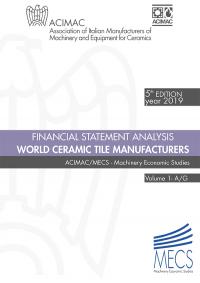Financial statement analysis of world ceramic tile producers

The new study by Acimac Research Department examines the 2015-2017 economic and financial data for 345 companies, of which 75 operating in Italy, 72 in Spain and 198 in other countries worldwide.
The Acimac Research Department has published its latest Financial statement analysis of world ceramic tile producers examining the 2015-2017 economic and financial data for 345 companies: 75 operating in Italy, 72 in Spain, 43 in other EU countries, 93 in Asia and 62 in other countries worldwide.
The 2017 financial statement analysis provided extensive information about the companies’ performance, structure and financial strength.
A comparison between companies based in Italy, Spain, Rest of Europe and Rest of World shows that the profitability of Italian companies was very similar to that of their Spanish counterparts over the three-year period 2015-2017 (ROI Italy: 5.3 and growing; ROI Spain: 5.1 and stable or slightly falling). However, companies in Italy and Spain reported inferior results in terms of gross and net profitability compared to the average performance of companies in other countries in Europe and the rest of the world.
But despite their similarities, Italian and Spanish companies also display some significant differences. Starting out from a comparable added value margin, the Italian companies achieve a similar level of EBITDA to their Spanish counterparts but with a business model that uses a smaller number of more productive and better paid workers. In other words, the Italian companies compensate for their smaller average size through the use of a more productive workforce. This is demonstrated by the level of added value per employee, which for Italian companies is more than 20,000 euros higher than the Spanish average.
It should be noted that the higher productivity of Italian workers goes hand in hand with a significantly higher level of labour costs per employee: 56,000 euros/year in Italy compared to 43,000 euros/year in Spain. However, this difference does not mean that Italian companies are any less profitable.
Italian ceramic companies have a higher level of invested capital per employee, with total assets per employee more than 90,000 euros higher than the corresponding figure for their Spanish counterparts.
Italian companies also have a lower level of capitalisation and consequently greater financial leverage through third party capital.
Both Italian and Spanish companies display good levels of liquidity and high financial strength. However, in terms of cash flow the Spanish companies have to deal with long trade receivables collection times but much shorter trade payables payment times.
Companies in the rest of Europe and in the rest of the world adopt rather different business models based on large company dimensions in order to exploit economies of scale in medium and medium-low product segments, high labour intensity and low labour productivity. More intense use of cheaper and more abundant labour (the average labour cost per employee is less than half of that of Spain and just over one third of that of Italy) makes the companies highly profitable and gives them an advantage of between one and a half and two percentage points in terms of net profit.
Although they operate in different average price segments, companies outside Italy and Spain have a very high level of economic and management efficiency, so there is a significant risk of them diversifying their production towards higher end segments and thereby increasing the competitive pressure on the European duopoly of Italy and Spain.
Did you find this article useful?
Join the CWW community to receive the most important news from the global ceramic industry every two weeks
























